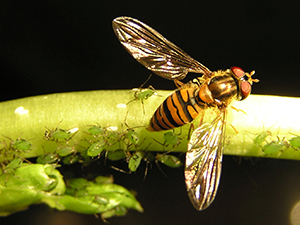
Last year, the European Union (EU) banned outdoor use of several neonicotinoid insecticides due to the risk posed to wild and managed bees. Several Canadian provinces have also recently placed partial restrictions on neonicotinoids, and some U.S. states have partially restricted the use of neonicotinoids as part of their Pollinator Protection Plans.
Because neonicotinoids are the most-used insecticides in the world, there has been pushback from growers based largely on the belief that neonicotinoids are an indispensable tool. But is that the case? This is the topic for our twenty-first “Notes from the Lab,” where we highlight “Alternatives to neonicotinoids,” written by Hervé Jactel and colleagues and published in the journal Environment International [129:423-429 (2019)].
Two years before the EU ban on neonicotinoids occurred, the French Agency for Food, Environmental and Occupational Health and Safety (ANSES) was commissioned by the French Ministry of Agriculture to assess the risks and benefits of alternatives (chemical and non-chemical) to neonicotinoids. This resulted in a group of independent scientific experts comprehensively assessing all available alternatives to neonicotinoids for pest management. For each neonicotinoid use, target pest and crop plant, all alternatives were identified and ranked in terms of their efficacy for controlling the target pest, applicability (i.e., the alternative was directly usable or requiring further research and development), durability (i.e., risk of resistance to target pests) and practicability (i.e., ease of implementation by farmers).
The panel considered eight categories of potential alternatives to neonicotinoids: 1) other chemical insecticides, 2) biological control with predators or parasitoids, 3) biological control with fungi, viruses or bacteria, 4) biological control via alternative farming practices, such as intercropping or crop rotation, 5) use of semiochemicals for activities such as mating disruption or mass trapping, 6) physical control, such as oils, nets or trenching, 7) genetically improved plants, and 8) plant defense elicitors. Each potential alternative was then independently given a semi-quantitative score (1-3) for efficacy, applicability, durability, and practicability by multiple experts following a systematic literature review of the topic. If major discrepancies occurred between the experts, a discussion took place and consensus values were determined.
The panel considered an alternative pest control method to be directly useable as a replacement (substitutable) for a neonicotinoid use if its overall score for efficacy and applicability was 2. Similarly, the substitutability of a category of potential alternatives was defined as the number of methods or products with efficacy and applicability scores 2 divided by the number of methods or products from that category. Overall, the panel considered 152 authorized uses of neonicotinoids concerning 120 target crops and 279 insect pests. They evaluated 2,968 case studies using the
….


